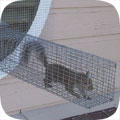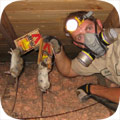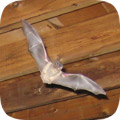- fishers@wildlifeanimalcontrol.com
Call 8 am-5 pm for a free quote:
317-215-0066
Fishers Wildlife Animal Control
Professional Wildlife Removal Company Servicing Fishers, IN
If you have a problem with wildlife in your Fishers home, your best option is to hire a company that specializes in Indiana wildlife removal only. This is a specialty business, and regular pest control companies do not use the proper techniques to solve animal problems. I have spent many years reviewing Indiana and Fishers, and I recommend the following:
Critter Removal Indianapolis
Cell Phone: 317-215-0066
NOTE: If you have a dog or cat problem, call Hamilton County Animal Services: (317) 773-4974

Critter Removal Indianapolis specializes primarily in removing animals from attics of homes and buildings - this includes squirrels in attics, raccoons, and rats or mice in homes. Indiana also has a documented problem with
bats in buildings, and Critter Removal Indianapolis is specially trained in bat removal. They also perform general wildlife trapping services, such as the capture and removal of skunks or opossums on the
property. Call 317-215-0066 to discuss your critter problem and schedule a same-day or next-day appointment. Click here to learn more about what prices we charge in 2020.
When hiring a company to solve your wild animal problem, you want these features:
- Specializes in wildlife removal, not pest control
- Fully Indiana and Hamilton County licensed and insured
- Works 7 days per week (critters don't take weekends off)
- Performs full building inspections: enters and inspects attic
- Performs exclusion repairs, with guarantee against animal re-entry
- Offers cleanup of biohazardous wildlife waste
Critter Removal Indianapolis is a full-service Fishers wildlife removal company. This is very different from a regular Fishers pest control company. The pest control companies spray poison to kill insects. This is not at all
similar to wildlife removal. Critter Removal Indianapolis performs a full inspection of the home or property, and determines why the animal(s) are there, and if inside a building, how the animals got inside. All
animals (including rodents) are trapped and removed, or if possible, removed from the building using special exclusion devices. Once the animals are gone, preventative repairs are essential, and
cleanup is sometimes recommended.
 Fishers wildlife trapping - it's not as simple as it may seem. It's illegal in Indiana to trap without a license. Trap type is very important and there are many different types, bait is somewhat relevant, trap placement
is vital, and there are dozens of small things that are very important to know.
Safety is a concern. Then once the animal is trapped, it must be removed and dealt with in the proper manner according to Indiana law. We offer Fishers raccoon removal. Read more about how to get rid of raccoons.
Fishers wildlife trapping - it's not as simple as it may seem. It's illegal in Indiana to trap without a license. Trap type is very important and there are many different types, bait is somewhat relevant, trap placement
is vital, and there are dozens of small things that are very important to know.
Safety is a concern. Then once the animal is trapped, it must be removed and dealt with in the proper manner according to Indiana law. We offer Fishers raccoon removal. Read more about how to get rid of raccoons.
 Animals in attics - this is our specialty at Critter Removal Indianapolis. Many types of animals like to live in attics. This includes squirrels, raccoons, rats, mice, bats, birds, and even possums. Critters like to go into attics for a safe place to live
and raise their young. Removing animals from attics is very complex work, partly because of the presence of baby animals. If you need Fishers squirrel removal, we can remove all the squirrels from your attic, and seal out any future ones. Read more about how to get rid of squirrels.
Animals in attics - this is our specialty at Critter Removal Indianapolis. Many types of animals like to live in attics. This includes squirrels, raccoons, rats, mice, bats, birds, and even possums. Critters like to go into attics for a safe place to live
and raise their young. Removing animals from attics is very complex work, partly because of the presence of baby animals. If you need Fishers squirrel removal, we can remove all the squirrels from your attic, and seal out any future ones. Read more about how to get rid of squirrels.
 Rodent control must be done in a very specific way. First off, the most important thing is that all the openings that rats and mice can use to enter a house be sealed. Then all the rodents must be physically trapped and removed.
Never, ever use poison! Most Fishers exterminators will just use this lazy poison technique to kill rodents, and it causes more harm than good - dead stinky rats, and it doesn't solve the problem. Call us for correct Fishers rat removal. Read more about how to get rid of rats.
Rodent control must be done in a very specific way. First off, the most important thing is that all the openings that rats and mice can use to enter a house be sealed. Then all the rodents must be physically trapped and removed.
Never, ever use poison! Most Fishers exterminators will just use this lazy poison technique to kill rodents, and it causes more harm than good - dead stinky rats, and it doesn't solve the problem. Call us for correct Fishers rat removal. Read more about how to get rid of rats.
 Bat removal is a highly specialized task. Indiana is known to have colonizing bats who often live in buildings. Bats love attics. If not removed, the colony can grow to a very large size over the years. The bat droppings are often corrosive and
cause health risks. The same goes for bird droppings on or in buildings. We perform Fishers pigeon removal and bird control. But our specialty is Fishers bat removal. We remove 100% of the bat colony and seal the building so that it's totally bat-proof. Read more about how to get rid of bats.
Bat removal is a highly specialized task. Indiana is known to have colonizing bats who often live in buildings. Bats love attics. If not removed, the colony can grow to a very large size over the years. The bat droppings are often corrosive and
cause health risks. The same goes for bird droppings on or in buildings. We perform Fishers pigeon removal and bird control. But our specialty is Fishers bat removal. We remove 100% of the bat colony and seal the building so that it's totally bat-proof. Read more about how to get rid of bats.
 If you have animals inside a house, no job is complete without proper exclusion repairs. If you simply hire a Fishers trapper who only removes the critters, then the problem will return. You need to hire a Fishers wildlife control company that identifies 100% of the animal entry points
into your building, and seals them shut with professional repairs. In addition, in many cases animals have left waste or contamination behind, and you'll want a company that can provide professional cleaning services. Critter Removal Indianapolis does both.
If you have animals inside a house, no job is complete without proper exclusion repairs. If you simply hire a Fishers trapper who only removes the critters, then the problem will return. You need to hire a Fishers wildlife control company that identifies 100% of the animal entry points
into your building, and seals them shut with professional repairs. In addition, in many cases animals have left waste or contamination behind, and you'll want a company that can provide professional cleaning services. Critter Removal Indianapolis does both.
The above are just some of the services offered by Critter Removal Indianapolis. We also trap and remove animals that destroy lawns, such as moles, or digging animals. Sometimes animals like opossums will live under buildings, steal pet food, raid garbage cans, etc.
Read about how to get rid of opossums. Skunks commonly live under sheds or decks, and set up a den. We can trap and remove them without them spraying. Read about how to get rid of skunks. Critter Removal Indianapolis
also provides dead animal removal in Fishers. If you need help with any other wildlife conflict, from a fox, beaver, groundhog, or any other critter, we can solve it. We also do Fishers snake removal - most of the snakes in Indiana are not venomous, but
call us if you want safe removal, or read about how to get rid of snakes in Fishers. And remember, we are a private business, not Hamilton County Animal Control Services, so if you have a dog or cat problem, call the County at (317) 773-4974.
Hamilton County animal services does not handle any wildlife issues.
Critter Removal Indianapolis: 317-215-0066
Fishers Pricing Info For Year 2020
 Every wildlife removal situation is different, from the species of animals involved, the location of the animal inside a house or outside, the extent of repairs or cleanup, etc. It's impossible to give one-size-fits-all prices. Examples MIGHT include:
Every wildlife removal situation is different, from the species of animals involved, the location of the animal inside a house or outside, the extent of repairs or cleanup, etc. It's impossible to give one-size-fits-all prices. Examples MIGHT include:
Small Job: For example, a one-stop job to remove an animal in the yard: $100 on up
Medium Job: For example, getting critters out of your house with minor repairs: $300 on up
Large Job: For example, a project involving many service trips and complex work: $500 on up
Give us a phone call now and tell us about your wildlife issue and we will be able to give you a price estimate over the phone. If you're cool with it, we can schedule a same-day or next-day appointment if you like. Our prices are fair, and a good value because we do the job right, the first time.
Fishers Wildlife Tip #1:
The Pigmy Rattlesnake: Appearance, biology, life cycle, habitat, diet, behavior
The pigmy Rattlesnake is a form of Viper, meaning that they are venomous snakes with extremely sharp fangs that released the venom into their victim once they have bitten into its skin. In addition to producing venom, these are also pit snakes, which means that they have a special sensor located in the pits between their eyes and nasal cavity which allows them to detect heat.
This is not only used to help defend themselves, but is an ideal source for detection of potential prey for them to use for food. These sensors are some of the most sophisticated of any sense that an animal has, allowing for it to detect even the slightest movement and to react with pinpoint precision to attack and subdue their potential prey. These are animals that are quite adept at winning battles, and is one of the reasons why have thrived in whatever niche they have created for themselves.
Rattlesnakes in general are extremely aggressive, and make for over 90 percent of all cases of fatality by snakebite among human beings in North America. This is because these animals do not normally backoff from any kind of confrontation. Instead, they coil and shake their rattle is a warning to any creditor that they should back away immediately. If the predator does not do so then they are ready to battle, never or at least rarely running away.
The Pigmy Rattlesnake is the shortest of any of the species, in terms of length. They have dark lines that run through each eye on the side of their face, and a series of round dark spots that run down the center of their back. The spots are interrupted by stripes that run along the side of their body. There also small splotches that go down the sides of their body on each side.
These species of rattlesnake are found primarily in the southern portion of the United States and Mexico. It is primarily because they need extremely warm weather areas like that that are found in Arizona, New Mexico, and Texas. However, there are some species of pigmy rattlesnakes that have been found in areas like New York, and even Ontario. However, this is the exception.
These rattlesnakes prefer to ambush potential prey. They will usually find a spot where they can sit, coiled, ready to attack. These are also extremely patient animals, known to remain coiled in one location for up to three weeks before striking out at a potential food source. They will eat a number of different kinds of animals, preferring such things as rodent's, birds, lizards, and frogs.
Reproduction occurs in the early part of the year, with the gestation lasting till about August. The male is the aggressor in the courting process, dominating the female and tell he is able to subdue her and begin copulation. A large male may actually keep a female under his control for more than one mating season to aid in the reproduction process. The average litter ranges between two and 12 snakes.
Fishers Wildlife Tip #2:
Indiana Wildlife Information:
Indiana State bird: Northern cardinal
State fish: Largemouth bass
Indiana is one of the larger states in the country, and it was sculpted millions of years ago by receding glaciers. The part of the state formed in this manner is full of rich soil, ideal for farming. Because the state is primarily rolling hills and flat plains, agriculture is the main focus of many people living in the region. Not surprisingly, farming brings with it a slew of animals that like to live off of crops. Probably the most detrimental of these species is the prairie dog. With an extensive network of tunnels, the smart mammal can inadvertently compromise structural integrity of buildings or cause machines to get stuck out in fields. If farmers are really unlucky, livestock, like cows, will get their legs stuck in the holes. A cow with a broken legs rarely recovers and lives another day.
But prairie dogs aren't the only creatures on the lookout for fields of crops. Wild hogs are problematic in Indiana. The large combative pigs only have a few natural predators: coyotes and cougars. The mountain lion won't eat a pig a day; if anything, it might eat a pig a week. Such a limited diet does nothing for population control. Coyotes are more apt to eat a number of pigs, but the hogs are so fierce, it would take a sizeable pack to run one down. Humans have been incorporated into the process of controlling these swine, and open seasons for hunting are common.
If the hogs and the prairie dogs don't get the farmers, the birds just might. Crop fields are favorite places for flocks of birds to congregate and eat seed. Most fields are so large and densely planted that a few crows or geese can't hurt them, but private farmers can lose an entire crop to over-zealous geese.
Even though there are no real mountains in this state, there are a number of deep stream ravines. These regions have allowed beavers to flourish, and the more pools the beavers create, the more animals like muskrats, blue herons, and frogs will be seen.
Indiana only has four venomous snakes, two of which are species of rattle snakes. The other two venomous snakes are copperheads and cottonmouths. There are 30 other non-venomous snake species in the state.
Raccoons, skunks, opossums, and squirrels are also abundant.
You can always call Critter Removal Indianapolis, any time of day, at 317-215-0066, for a price quote for Fishers wildlife control services. I am confident that this is the best choice amongst wildlife removal companies in Fishers, IN.





































